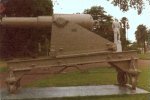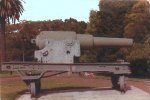The Gun - Rifled Ordnance: New heavy RML equipmentsOrdnanceHeavy guns, where used for both land and sea services, were identical. During the 1860s, the British were concerned at the increasing strength of iron-clad ships, especially those of the French fleet across the channel. The heaviest Armstrong rifled breech-loader, the RBL 110-pr (7-inch) had not come up to expectations. As Armstrong himself had foretold, his system was not entirely suitable for heavy guns; the muzzle velocity of the 110-pr was not high enough to defeat the warships' armour - and the breech mechanism would not stand any increase in propellant charge to make it higher. Priority was therefore given to the construction of the heavy natures of RML guns which began with the recommendation of the ordnance Select Committee which sat in 1866. Four systems of construction ensued; the 'original' followed Armstrong's 'built-up' system, the superiority of which had been duly recognised by the Committee. Subsequently, three other systems evolved, the 'modified', 'Fraser' and 'Royal Gun Factory' (RGF), incorporating improvements in strength and simplicity, but all retained the same basic principles, ie a steel 'A' tube over which other tubes and/or fittings of wrought iron were shrunk. Guns included the 64-pr 64-cwt, 7-inch 4½- 6½- and 7-ton, 8-in 9-ton, 9-in 12-ton, 10-in 18-ton, 10.4-in 28-ton, 11-in 25-ton, 12-in 35-ton, 12.5-in 38-ton etc up to 17.72-in 100-ton. The New Zealand Government bought eleven each of the 64-pr 64-cwt and 7-in 7-ton guns in 1878 at the time of the 'first Russian scare'. However, by the time they arrived here in 1879 the 'scare' had passed so they were put into store and apparently forgotten until the next 'scare' in 1885 when they were mounted 'in all haste' (to quote the Fort Record Book). The Kiwi she's right attitude is older than you think!
Manufacture of the Mark 3 gun began in 1867 although the guns received in New Zealand in 1879 were made in 1878. It differed from earlier marks mainly in having fewer parts. It is built up of four portions, ie the 'A' tube of steel, the breech coil to which the trunnion piece is welded before being shrunk on the gun, the 'B' tube, and the cascable screw, all of wrought iron. On the right of the cascable is a gas escape leading to the end of the 'A' tube. The bore is rifled with three plain grooves on the Woolwich system with a uniform twist of one turn in 40 calibres. Full charge was 8 pounds of powder, MV was 1390 fs, range 4000 yards. The 64-pr was not designed for the defeat of armour but rather to attack the upper works of ships. To digress from technicalities for a moment, two of the 17.7-ton guns mentioned above were installed at Gibralter - and thereby hangs a tale. During a practice shoot one of the guns misfired, and was ordered to be unloaded. What had happened to the 'instrument extracting projectile' supplied for the purpose is not recorded, but a small Drummer Boy - having been assured 'it was perfectly safe' - was persuaded to crawl down the barrel and attach a rope to the shot. When he crawled out legend has it he was immediately promoted to Corporal! Carriages and PlatformsPlatforms were sometimes referred to as slides. The new RML 64-pr 64-cwt (6.3-inch) equipment received in New Zealand in 1879 was called 'Carriage garrison sliding on Platform reversing dwarf'. The 'dwarf' part of the nomenclature simply indicated the platform was lower than the other equipments, ie the wheels were smaller.
The gun and carriage were said to be mounted en barbette, that is to say on a sloping iron platform behind a parapet over which the muzzle protruded in the firing position. While the centre of the platform was secured to a pivot set in the concrete gun floor, each end of it stood on a pair of 'trucks', or small flanged wheels, which ran on a circular rail set in the floor. Thus the complete equipment could be traversed through any angle up to 360° according to the sector the gun was expected to cover.
On firing both gun and carriage recoiled up the sloping platform, being held there while the gun was reloaded. Loading completed, gun and carriage were released to run out down the platform to the firing position once again.
Another heavy gun worthy of mention is the RML 7-inch 7-ton. Except for size the equipment, ie gun, carriage and platform, closely resembled the 64-pr 64-cwt in outward appearance, but it was more powerful. With full charge of 0 lbs powder MV was 1561 fs, range 5500 yards with a QE of 11°, and with a reduced charge of 17 lbs 4000 with a QE of 9°52'. With full charge a shot could penetrate 6.72 inches of wrought iron at 500 yards. It employed the same system of rifling as the 64-pr but with a uniform twist of one turn in 35 calibres.
As already mentioned, with the 64-prs received in 1879 there arrived eleven 7-inch 7-ton guns on 7-ton carriages - all brand new according to Government records.
The guns were in fact new, having been made in 1878. However, in the Fort Cautley Record Book we find: "... instead of new 7-ton carriages being made and coming with the guns, old sea-service 6¼-ton carriages were converted for the purpose and sent out. Like all naval carriages of the same nature they were originally fitted with the EOC compressor, and although well filled up and painted over, the positions of the holes for the compressor shaft and lever bracket are still visible. The naval service metal brushes for the breeching rope are also still fitted in the holes in the brackets of the carriages."
We are left to wonder: Did the New Zealand taxpayer pay for new carriages as ordered - or for the second-hand ones received?
NB: The 'compressor' was a crude recoil-limiting device made of two sets of metal plates, one attached to the carriage, the other to the platform. When sqeezed together by the lever mentioned they acted as a brake on the carriage.
In 1904 all 64-pr and 7-inch guns were taken out of service and the complete equipments presented by the Government to local bodies in the four main centres. There they were displayed in local parks etc as memorials - reminders of events in the country's history.
Then during the 1930s there arose a group of peculiar people who thought that if all guns were hidden there would be no more war! They petitioned local councils to bury the old relics or sell them for scrap, and were successful in anumber of cases. The guns in Albert Park, Auckland, survived until the Japanese entered World War 2 in 1941, when the same people petitioned the Auckland City Council to bury them. They claimed that Japanese aircraft seeing the ancient pieces might mistake them for modern armament and bomb the city!
To the amazement of normal people the Auckland City Council capitulated! Council workmen buried the guns but not before vandalising them by removing the non-ferrous parts and cutting the platforms in half - easier than digging a bigger hole. When in 1977 the guns were 'resurrected' the City Council made an extremely poor attempt at restoring them.
.../Heavy Field and Siege Artillery
WL Ruffell, 1999
previous | index | next |
History index | Home
|



 The figures show two of the 'resurrected' guns, left:a 64-pr, right: a 7-inch, both ex-Fort Cautley, North Head. Non-ferrous parts have been removed, eg carriage trucks and breeching rope hole bushes (7-inch, below the trunnions). Both central pivots are missing; these were dug up but the Council in its 'restoration' made no attempt to replace them on the guns. Neither did they replace the footboards formerly fitted to the platforms for use by the detachments. Note also the botched attempt to join the two halves of the 7-inch platform.
The figures show two of the 'resurrected' guns, left:a 64-pr, right: a 7-inch, both ex-Fort Cautley, North Head. Non-ferrous parts have been removed, eg carriage trucks and breeching rope hole bushes (7-inch, below the trunnions). Both central pivots are missing; these were dug up but the Council in its 'restoration' made no attempt to replace them on the guns. Neither did they replace the footboards formerly fitted to the platforms for use by the detachments. Note also the botched attempt to join the two halves of the 7-inch platform. Right: NZ Armed Constabulary detachment at gun drill on a RML 7-in 7-ton gun, the emplacement for which they constructed, at Summit Battery, Fort Cautley, North Head, in 1886. They are manning tackles to bring the carriage and gun back to the loading position. The instructor is an RA NCO. From 1 Sep 1886 NZAC Field Force and Reserve personnel were given the option of joining the NZ Permanent Militia or the NZ Police. Those who joined the former were posted as Gunners, became members of the NZ Permanent Artillery, which in turn became the RNZA in 1902. Note that the glengarry was an item of headdress worn by the NZAC, and they had a special badge to go with it.
Right: NZ Armed Constabulary detachment at gun drill on a RML 7-in 7-ton gun, the emplacement for which they constructed, at Summit Battery, Fort Cautley, North Head, in 1886. They are manning tackles to bring the carriage and gun back to the loading position. The instructor is an RA NCO. From 1 Sep 1886 NZAC Field Force and Reserve personnel were given the option of joining the NZ Permanent Militia or the NZ Police. Those who joined the former were posted as Gunners, became members of the NZ Permanent Artillery, which in turn became the RNZA in 1902. Note that the glengarry was an item of headdress worn by the NZAC, and they had a special badge to go with it.